"Student theater" is one of the many Waseda cultures. Students are devoted to creative activities, with many stage productions being held mainly by student club at Waseda University Student Center, the Atelier behind Okuma Auditorium (commonly known as Kumura), and Waseda Shogekijo Drama-kan Theater. In addition, the Waseda University The Tsubouchi Memorial Theatre Museum, Waseda University (commonly known as ENPAK) regularly holds various special exhibitions, and displays valuable theater materials that will make any enthusiast drool.
To gain a deeper understanding of the theater culture that Waseda University is so proud of, we have planned a tour of the theater spots on campus. Actor Shinya Kote (1999 graduate School of Education), who once spent his student life at Waseda completely focused on theater, will be touring the campus with current students. As Kote shares his precious memories of that time, you will be able to experience the one-of-a-kind theater culture that you won't find at other universities.
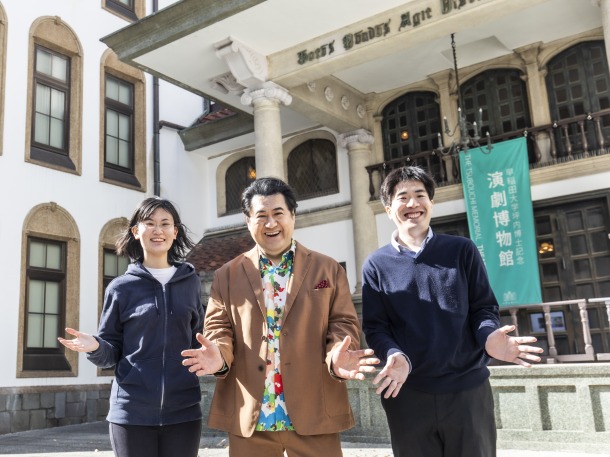
In front of the Waseda University Theatre Museum Waseda Campus. (From left) Iinuma, Kote, and Sekine
INDEX
▼ Spot 1〈Waseda University Theatre Museum〉Kote Shinya was excited to see Enpaku for the first time!
▼Spot 2〈Okuma Auditorium Backstage〉Is this where the theatrical demons live? Remembering Masato Sakai at "Okuma Backstage"
▼ Spot 3〈Waseda Shogekijo Drama-kan Theater〉Bump into your juniors at your old theatre!
▼After the theater tour: Experiencing theater is an irreplaceable experience
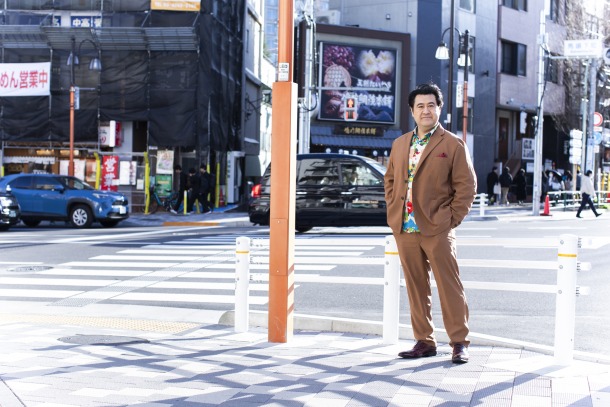
At baba intersection. Many passersby cheered on the group as they struck a pose!
On a certain day in a certain month, Kote-san rushed to the meeting place at baba intersection in the midst of a hard schedule of rehearsals for the next performance. Here is a word about his enthusiasm for today!
Kote
Ever since I was in high school, I loved the works of the theater student club "Kumkum Minikina" (whose leading actor at the time was Yashima Norito), which was founded by members of the Waseda University Drama Club (commonly known as Enkura), a Waseda University drama circle. I wanted to join the same student club, so after failing the entrance exam twice, I finally achieved my dream of becoming a Waseda student. I only found out that Enkura was an intercollegiate club after I joined... (laughs). During my student days, I spent all my time hanging out at the now-defunct Second Waseda University Student Center, immersed in theater. It's been about 30 years since then, and I'm looking forward to hearing from a Waseda student who is now passionate about theater about the current state of Waseda theater!
Spot 1〈Waseda University Theatre Museum〉 Kote Shinya is excited to see EMPAK for the first time!
The first place we visited was the Waseda University The Tsubouchi Memorial Theatre Museum, Waseda University (commonly known as Enpaku). It was established in 1928 to commemorate Tsubouchi Shoyo's 70th birthday and the completion of the translation of the 40-volume "Complete Works of Shakespeare," and since then, it has been collecting valuable materials on theater and film from not only Japan but all over the world. And best of all, admission is free for everyone! From here, we will be guided around the museum by Enpaku student staff member Sekine Ryo, a second-year student in the Doctoral Program in Theater and Film Studies at the Graduate Graduate School of Letters, Arts and Sciences.
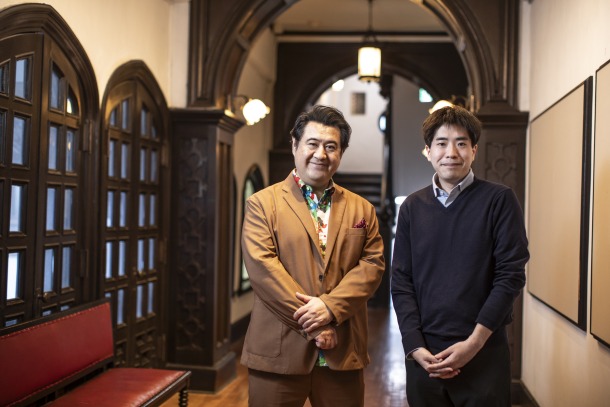
The nostalgic atmosphere of the second floor hallway is perfect for taking photos. The creaky wooden floors add to the atmosphere.
Kote: To be honest, this was my first time visiting Enpaku. I was crazy about theater at the time, but I had never paid any attention to a theater museum.
Sekine: What a waste. The Theatre Museum has a huge collection of about a million items, including 48,000 nishiki-e prints, 400,000 stage photographs, 270,000 books, 80,000 theatrical performance materials such as flyers and programs, and 159,000 natural history items such as costumes, dolls, letters, and manuscripts. It's almost as if the history of theater is packed into this building. In fact, recently, a flyer for a performance that Kote-san made as a student was donated and added to the Enpaku collection.
Kote: What?! That's a lost flyer that I no longer have in my possession.
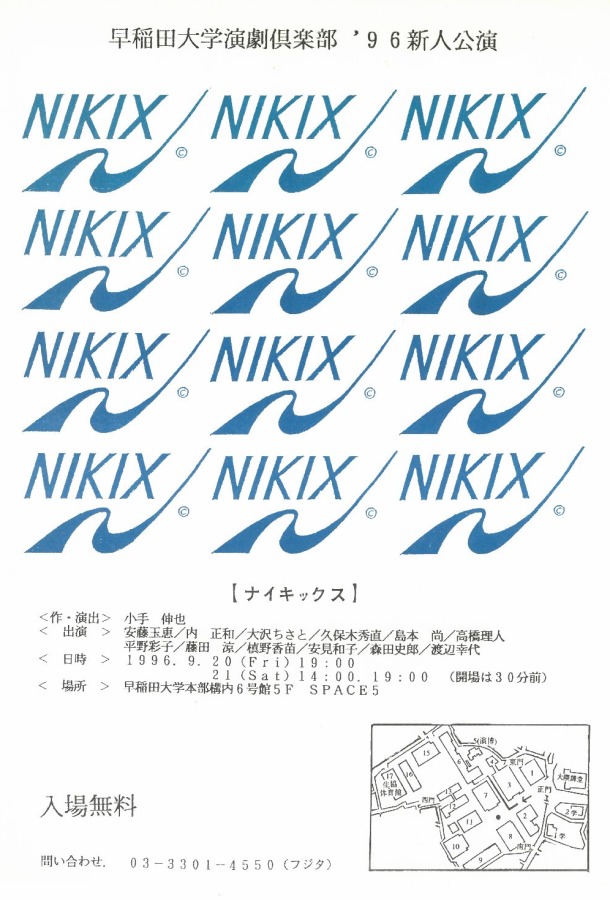
A flyer for a play he wrote and directed as a student. The actor Tamae Ando also appeared in the play. "Ando was a first-year student when I was a third-year student, so I could say she was my student. I never thought she'd become so popular!" (Kote)
Sekine: Before we go in, let me first show you the exterior of the building. This building was designed to resemble the Fortune Theatre, a British theater from Shakespeare's time. It has the shape of an open-air theater, with the stage directly in front of the entrance and the wings on either side being the boxes where the audience sits. Apparently, long before Kote's time, student student club also used to perform on that stage. Let's go inside!
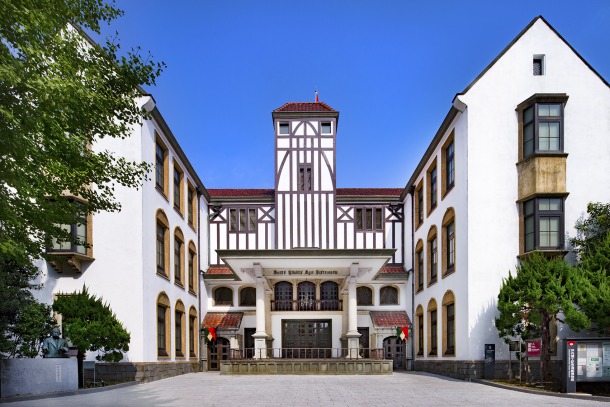
Enpaku seen from the front. It is designated as a tangible cultural property (building) of Shinjuku.
Kote: Wow, the inside of Enpaku has such an extraordinary and charming interior. I can't believe they have such a facility on campus. Waseda is truly impressive!
Sekine: The three-story Enpaku has the "Machiko Kyo Memorial Special Exhibition Room" on the first floor, which traces the history of film and TV dramas, the "Shoyo Memorial Room" on the second floor, which displays Tsubouchi Shoyo's favorite items, and the "Special Exhibition Room," which holds exhibitions on various themes, and the third floor, which has an exhibition of Japanese and international theater. There is no set route, so you can freely view the exhibits in the order that interests you. What genre are you interested in, Kote-san?
Left: Kote greets the bronze statue of Shakespeare that greets visitors at the entrance
Photo on the right: The Shoyo Memorial Room on the second floor. The interior incorporates Elizabethan design, and the ceiling is decorated with sheep, which is Shoyo's zodiac sign.
Kote: I'm interested in all of them, but I think I'll probably go for the theater on the third floor. I'd like to take a quick look at the history of world theater, and then take a closer look at Japanese theater. Wow, so Japanese theater is divided into three rooms by history: "Ancient and Medieval," "Early Modern and Modern I," and "Modern II and Contemporary." I'm looking forward to it.
Sekine: Let's start with the European and American exhibits on world theater. Here, we can see the history of theater starting from ancient Greek theater and developing in its own way in each country. After the Second World War, we can see the emergence of absurdist theater (avant-garde theater that originated mainly in France in the 1950s) by artists such as Beckett. Kote-san is currently preparing to perform an absurdist theater performance.
Kote: That's right. We are currently in the middle of rehearsals for a work by playwright Minoru Betsuyaku, who was influenced by Beckett and built the foundations of absurdist theater in Japan. There is also a poster from the time of "Waiting for Goto." This is the first time I've seen it. If I had it hanging in my house, people would think I was something special (laughs). Actually, I haven't had much exposure to classical or modern theater, but as I've grown up, I've come to appreciate the greatness of my predecessors. That's why I'm really happy to be exposed to Betsuyaku's work now, and I'm overwhelmed with emotion to see the Beckett poster, which is a coincidence.
(*) Appeared in the Sis Company production "Dry Weather and Five Gentlemen" (written by Betsuyaku Minoru, directed by Kato Takuya), which was performed from April to May 2024.
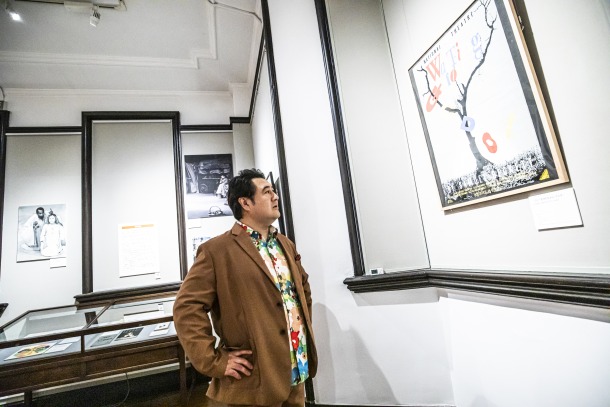
In front of a poster for Beckett's "Waiting for Goto"
Sekine: "Modern II/Contemporary" exhibits materials from the Taisho era to the Reiwa era. There is a rough historical overview, but I wonder if it also includes theater troupes that were popular during Kote's student days?
Kote: (Looking at the timeline) There are also theater companies that I watched in real time. I started mine in 1998, so it would be around here. It also mentions how Daisuke Miura, who was one year younger than me and started a theater company called "Potsdol", won the Kishida Kunio Drama Award for "Love's Whirlpool"! Miura surpassed me in no time (laughs). Oh, there's also a section on recent 2.5-dimensional theater. I think a lot of current students will be interested in this.
Sekine: That was a quick overview, but how was your first experience with Enpaku?
Kote: Sorry, I was underestimating the quality of the exhibition! It was so much fun that I wanted to watch it for another five hours. When I look at the absurdist theater that I will be performing next time, I feel a different kind of emotion when I see it in the context of the long history of theater. As the exhibition gets closer to the present day, I feel an indescribable sensation of seeing more and more people I know (laughs), and I was able to feel once again that I am part of this big flow. I would like to visit again soon.
Left: The two of them playing at a photo spot where you can transform into the Rose of Versailles
Right photo: Goods from the theater group "Caramel Box," founded in 1985 by Yutaka Narii, a member of the theater student club "Teatro 50'." This shows the theater boom of the 1980s and 1990s.
Spot 2: Okuma Auditorium Backstage: Is this where the theatrical demons live? Remembering Masato Sakai at "Okuma Backstage"
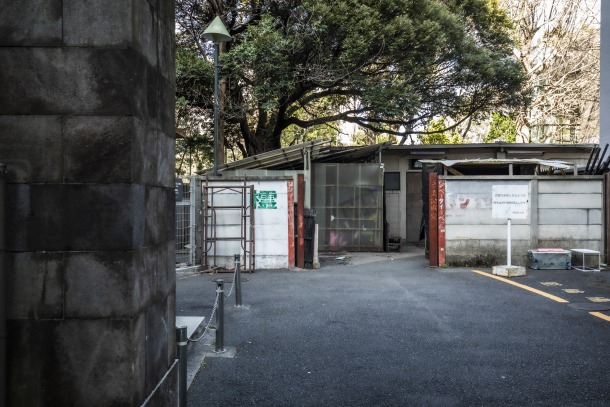
Near the entrance to Kumagura. You can see the Kodama Theater Company's studio in the background.
Our next stop was the back side of Waseda University's Okuma Auditorium, commonly known as "Kumaura." There are three studios belonging to Waseda University's officially recognized student club, the Stage Design Research Group, the Waseda University Theatre Research Group, and the Kodama Theatre Company, and the area is used daily for theater rehearsals, stage work, and performances. The area has been used for a long time as Waseda's theater scene has progressed, and even now that the building has deteriorated, the three student club are still active in Kumaura. Ms. Yumiko Iinuma (2nd year, School of Humanities and Social Sciences), a member of the Stage Design Research Group, and Mr. Daiki Endo (2nd year, School of Law), General Secretary of the Kodama Theatre Company, will guide us around this deep theater spot.
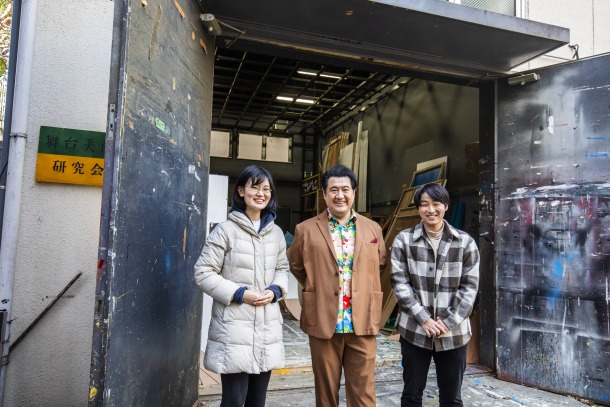
In front of the Stage Design Research Group's studio. (From left) Iinuma, Kote, and Endo
Kote: Wow, it hasn't changed at all! The atmosphere is still the same as it was back then, as if the demons of theater were living there. The student club group I was a member of didn't have an atelier in Kumagura, but I would often come here to borrow scaffolding from Masato Sakai, the "Prince of Waseda," who was a member of the Theater Research Club (commonly known as Gekiken). I'm the same age as Sakai, but because I failed the entrance exam twice, I'm two years older than him. That's why I still use honorific language (laughs).
Endo: It is very encouraging for students in the theater student club to see senior members of Waseda University's theater club, such as Kote-san and Sakai-san, active in stage and film productions! Let me show you around the studio of the Stage Design Research Group (commonly known as Butabi), which still uses the sets of most of the theater student club at Waseda University.
Kote: That brings back memories! The inside of the studio is still the same as it was back then.
Iinuma: One thing that has changed since Mr. Kote's time is that we have recently expanded the scope of our orders from the stage art we used to produce mostly for Waseda's drama student club. We also make monuments for the university's joint welcome performances.
Kote: We were really grateful for the help we received during the Buta-tabi period. It probably wouldn't be allowed now, but when we got busy with work, we all slept here.
Iinuma: I often hear such passionate stories from graduates and seniors (laughs). Nowadays, we have to be strict about leaving by 10 p.m.
Kote: Wow, times have changed, haven't they? But I'm glad to see that the passion at the core of your work remains the same.
Left: A small stage constructed in the Kodama Theater Company's studio
Right: The Stage Design Research Group's studio. The stage props are lined up in a cramped space.
Spot 3〈Waseda Shogekijo Drama-kan Theater〉Bump into your juniors at your old theatre!
Well, the theater tour is drawing to an end. Finally, we walk down Waseda University South Gate Street, heading for Waseda Shogekijo Drama-kan Theater, a place that holds many memories for Kote. It was founded in 1966 as the Waseda Little Theater Company, formed by Suzuki Tadashi, Betsuyaku Minoru, Ono Seki and others. After being privately managed, it was purchased by Waseda University in 1997 and began renting out to student groups as Waseda University Art Plaza Dramakan. It reopened in 2015 as the current Waseda Shogekijo Drama-kan Theater, where various performances are still held, mainly by drama student club. Continuing from Kumagura, Iinuma guided us.
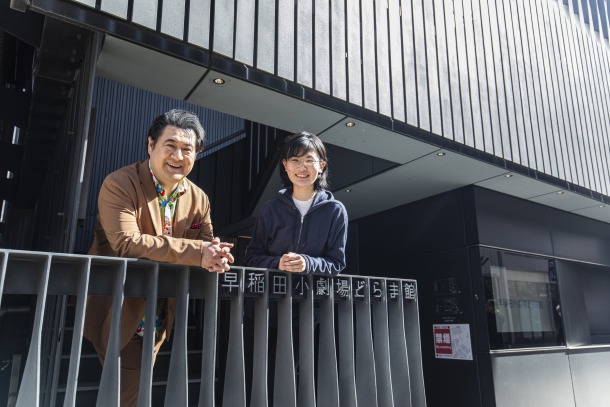
At the entrance to Dramakan. (From left) Kote-san and Iinuma-san
Kote: In our time, Dramakan was always booked up so quickly that drama student club were fighting over it. For Enkura, who didn't have their own studio, it was like a home, but it was an important theater that created a sense of tension that we had to put on a decent performance. At the time, each student club was like a rival, and we would sometimes go there to check out each other's new performers' performances.
Iinuma: That's true. Nowadays, we even hold unit performances that go beyond the boundaries of student club. Right now, at Dramakan, there is a joint performance between Enkura, a junior group of Kote-san's, and a unit called The Tarlys.
Kote: Unit! That's changed.
Left photo: Coincidentally, this was the day of a performance by his former band, Enkura. The kind and gentle senior was quietly watching over the juniors at the entrance, trying not to get in the way of them as they were busy dealing with the audience and setting up the stage.
Photo on the right: With friends from Enkura when he was a third-year university student. Kote is in the second row from the front, second from the right.
Iinuma: Speaking of things that have changed, it's not just theater, but also comedy student club live shows and hero shows by the "Kaiju Alliance" (an officially recognized student club). Even if you're not a theater fan, it's a good opportunity to experience the theater.
Left photo: Interior of the Dramakan. The stage is on the right, and the audience seats (72 seats) are on the left. The closeness of the stage to the audience seats, where you can even feel the actors' breathing, is the charm of small theaters.
Photo on the right: Atsushi Mizoguchi (left), the manager of Dramakan, called out to Kote. He was a man who had become obsessed with theater at Waseda University at the same time as Kote. "When I was wondering whether I should continue acting, I saw the inaugural performance of Kote's theater company, innerchild, called "Hitokatamari," and decided to continue. Today I was finally able to thank him!" (Mizoguchi)
After the Theatre Tour: Experiencing theatre is an irreplaceable experience
This concludes the theater tour. Please give us your thoughts on today and a message for Waseda students.
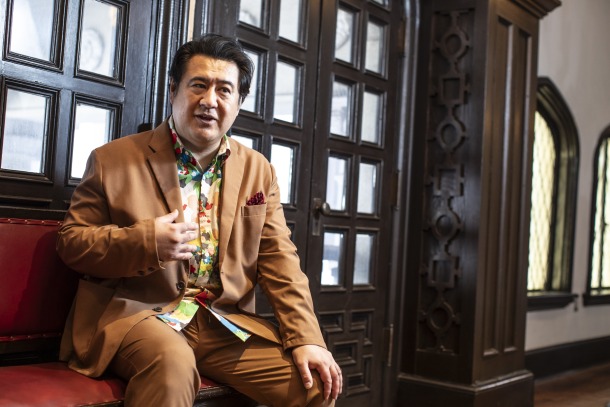
At Waseda University Theatre Museum
Kote
After visiting these three locations, I once again realized that I want many students to see live theater. The world of theater is a mixed bag, but if you get hooked, it has the power to change your destiny. Recently, there has been a crossover between theater and film actors, and 2.5-dimensional theater has also fused anime and theater, so I feel like the barrier to theater is a little lower. You can also go to the theater because of your favorite actor or the stage adaptation of your favorite anime. After all, experiencing theater in front of you is a truly irreplaceable experience, so I hope you will come to the theater for any reason. As a starting point, I would like you to visit these theater spots with a relaxed attitude and experience Waseda theater for yourself.
Interview and text: Kyoko Suemitsu (1998 Graduate of School of Science and Engineering)
Photo by Kota Nunokawa
[Next Focus Preview] "Seminar House Special" to be released on Monday, June 24th

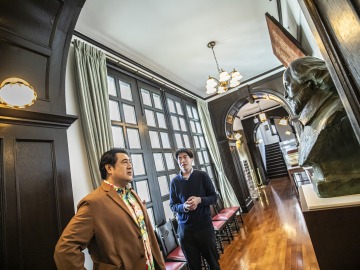
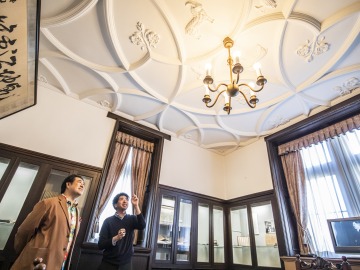
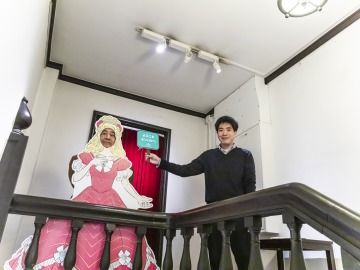
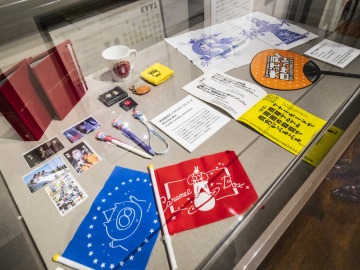
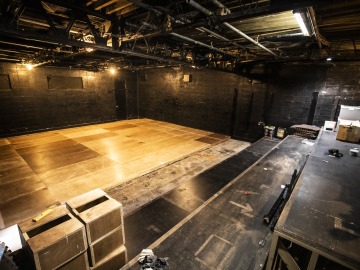
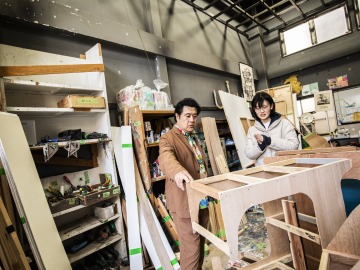
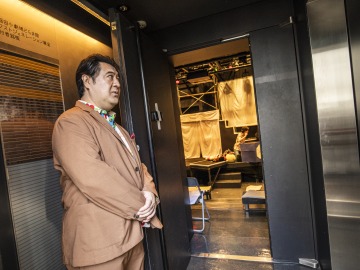
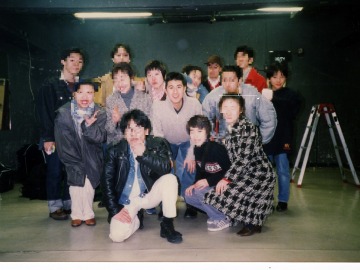
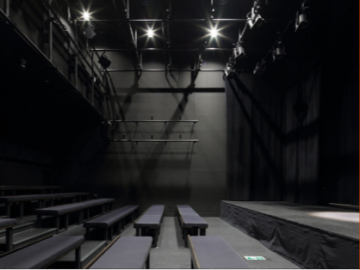
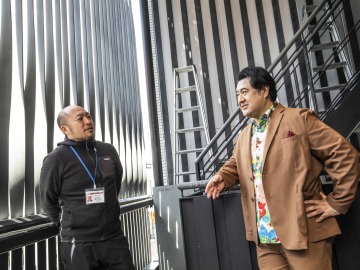

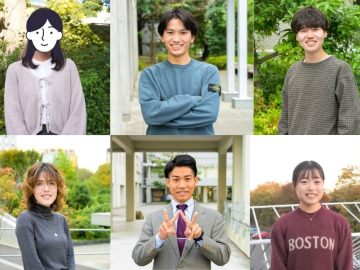
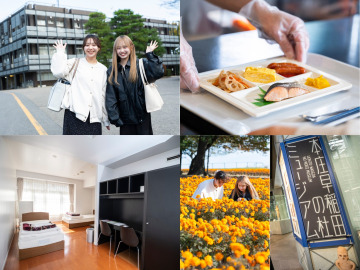


![[Save version] Map of the four main campuses](https://www.waseda.jp/inst/weekly/assets/uploads/2025/09/17cb2975123fc5103172ef60bd98608d-610x458.jpg)

